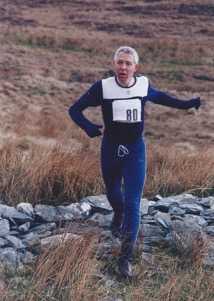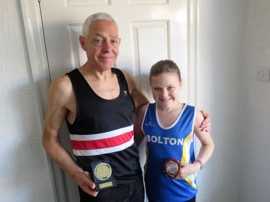David Ashton – A Lifetime in Athletics (Part 3)

If you haven't done so already, be sure to checkout part one and part two of David's memoir.
Manx Mountain Marathon 1995. 2nd placed finish and 1st over 40. The pinnacle of my running career. All downhill from here performance wise but certainly no loss of motivation and enjoyment.
Why no club vest? (A hot topic at recent committee meetings).
What’s a middle-distance track runner doing running a Category A Long Distance Fell Race?
Answers below…
No club vest
Autumn, 1983. After the two opening fixtures of the cross-country season I left club athletics.
The reason?
My mum was suffering terminal cancer and as a family we made the decision to support from home alongside doctor visits and Macmillan nurses. This together with school sporting commitments meant I could not be relied on for races. I’ll be honest, too, in saying the motivation for races was not what it had been.
However, my love of running did not decrease. Looking back I believe it was the jogging boom of the early 1980’s which saved me from leaving the sport. Most athletes called it a day once their peak level of performance had passed. Yes, there were veteran runners but nothing like the silver-haired, bus-pass class numbers that run and race today. The jogging boom helped in that I didn’t feel conscious of being out of place when running.
I soon found that running without racing lacked a challenge and more importantly the opportunity to travel and meet people. As a consequence I joined the Fell Runners Association and ran unattached from 1983 to 2008.
Fell Racing
I’d had plenty of experience of racing on the fells and although a specialist track runner I found considerable ability in running up hills. The same was not true on descents and in races I’d count the numbers who overtook me going downhill. This was particularly apparent in short and medium category A races where the ascent was too steep to run and any advantage I might have had was cancelled out. Through experimenting with different types of fell races I found that my best results came in long distance events. One event in particular, the Manx Mountain Marathon, fell into this category and a second athletics career opened up.
If I might offer advice to all you runners it would be to experiment with different distances and terrains and know which gives the best results.
The Manx Mountain Marathon
This race became an obsession and for over 25 years dominated my race programme. Some years I only did the one race. Through a series of bullet points I’ll share some of that obsession.
- The race is 31.5m (50km) and has 8000ft. of ascent with 12 summit check points.
- When I talk to non-runners about the event they, firstly, think I’m mad and, secondly, that one has to run up and down 12 mountains.
- This is not the case. Yes. There are steep climbs and descents but there is also a lot of running terrain within the race.
- The event offers magnificent scenery with spectacular views. As well as the obvious mountain terrain there are coastal paths and woodland plantations to add variety.
- On the down side there is a lot of heather and gorse on route and the middle section requires navigational skills.
- Until recently the race took place on Easter Saturday and as a consequence most runners from the mainland made a weekend of the event.
- I became friends with the Clayton Le Moors runners over a number of years. One memory is running with Peter Browning of that club for twenty miles of the race. Peter is 6ft 4ins and I just about reach 5ft 5ins. We were both regular runners at the event and got lots of support and encouragement en-route. We must have looked comical with the height difference and I’m reminded of seeing Peter Crouch lined up alongside Shaun Wright Phillip as substitutes in an England game.
- Training started on January 1st each year and everything was geared to the one event. This consisted of long endurance runs and getting the body used to being out for considerable lengths of time.
- One of the sad obsessions was a strategy I used for getting to sleep at nights. Instead of counting sheep I went over the course in my head weeks before the event. IT WORKED!
- Quite often we enjoyed a family weekend. Gill always acted as my back-up and was on hand at counter-checkpoints with refreshments and encouragement. My daughters and son-in-laws also attended and in later years I got cheers from flag waving grandchildren
- Gradually over the years my times got slower. It would be interesting to graph this downward trend as age affected ability. However, enthusiasm and enjoyment never wavered.
- In 2015 I returned to the race after a 4 year absence. This time my performance nose-dived and I was some 2.5 hours below my best times. (The graph would show a similar reading to the £/$ fall post BREXIT).
- Finally I’ll share my claim to fame regarding this race. Sadly, it’s not my top ten finishes and age category awards and records. My claim to fame lies in giving a lesson in how not to cross a mountain stream which was posted on a 2009 YouTube video:
Bizarre Injury Number Two and My First Real Injury
In part 1 of these memories I recalled the burn to my neck following the finishing tape not being at chest height. Forty years later I suffered a second head injury. This time I skidded off a woodland path in freezing weather and … SLAM! I literally head-butted the tree. Joking apart I was incredibly lucky not to pass out. The pain was really intense and I gingerly walked the two miles back home. There was an upside to this injury. Being a school teacher the sight of me was too scary for children to witness so I had to take some time off work. These two injuries probably confirm your impressions of me as a TOTAL HEAD-CASE!

I had been incredibly lucky regarding injuries until March, 2012. On an easy run my knee just gave. No spectacular fall on a fell-descent just a gentle run in a country park. I knew instantly it was serious because as well as the severe pain I couldn’t put any weight on my right leg. Again a hobble back home was required. The injury was real and threatened any future running. It has a posh name and took an age to learn the spelling – osteoarthritis. This means the cartilage has worn and bone is rubbing on bone. For two years I moaned and groaned and tried to console myself that I’d had 48 years of competitive athletics but, boy, did I miss the harrier scene and the buzz of race days. Gradually I got back to jogging and after a two year injury returned to racing. My training now consists of L.S.D. (no, not the American psychedelic drug) but Long Slow Distance a system pioneered in the 1970’s My knee allows this but will not stand up to intense sessions. It’s a small price to pay to be back racing. One final note regarding injuries I’d like to share. On my first race back following a two year absence the sheer delight and encouragement given by the Manchester YMCA Harriers will stay forever in my memory.
The Future
In January 2008 I re-joined the Manchester YMCA Harriers. There is a record of this by a certain Brian Ashton in the corridor of the Y Club. Obviously a cloned version of me. It was a great decision and I just love being part of the club. How long can I go on? Who knows? I’ve certainly no intention of retiring… in fact there’s another landmark age-group category not too far on the horizon.
My grandchildren Hannah, Sam, and Jessica are all members of Bolton United Harriers. You can imagine the emotions I experience when I observe them training and racing at a track where I have so many positive memories.

Hannah is holding the award for U11 girls team in the Red Rose League and I’ve got the Over-60 team plaque for the South East Lancs League.
Watch out the Brierleys the Ashtons are coming! Well, perhaps in 10 years or so!
Almost at the end. Thank goodness for that did I hear you ask? Oh!
By the way there will be a test so I know whose read these memoirs. How will it be marked? Easy, I’ll observe you staring at my oversized right knee.
Finally, there, promise.
— David Ashton, December 2016